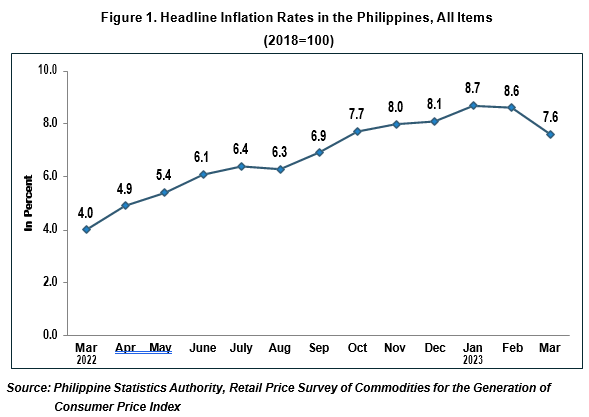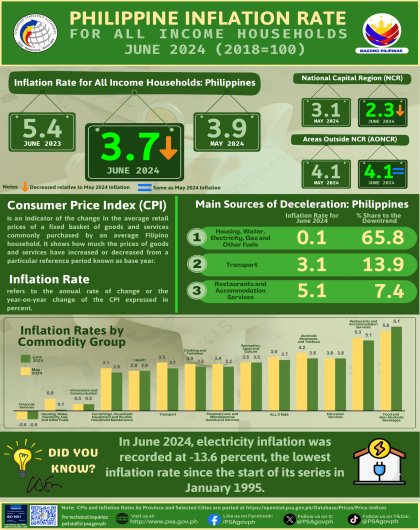Summary Inflation Report Consumer Price Index (2018=100): June 2024
Table A. Year-on-Year Inflation Rates, All Items
In Percent
(2018=100)
|
|
|
|
|
|---|---|---|---|---|
| Philippines | ||||
| Headline | 4.0 | 8.6 | 7.6 | 8.3 |
| Core | 2.2 | 7.8 | 8.0 | 7.7 |
| NCR | ||||
| Headline | 3.4 | 8.7 | 7.8 | 8.4 |
| AONCR | ||||
| Headline | 4.1 | 8.5 | 7.5 | 8.2 |
| Source: Philippine Statistics Authority, Retail Price Survey of Commodities for the Generation of Consumer Price Index *Year-on-year change of CPI for January to March 2023 vs. 2022 | ||||

A. Philippines
1. Headline Inflation
Headline inflation or the overall inflation in the Philippines slowed down further to 7.6 percent in March 2023 from 8.6 percent in February 2023. Inflation rate in March 2022 was lower at 4.0 percent. The average inflation for the first quarter of 2023 stood at 8.3 percent. (Tables A, B, 5, and 14, and Figure 1)
1.1 Main Drivers to the Downward Trend of the Headline Inflation
Among the 13 commodity groups, the continued downtrend of the overall inflation in March 2023 was mainly brought about by the heavily-weighted food and non-alcoholic beverages, which recorded a lower inflation rate of 9.3 percent from 10.8 percent in the previous month. This was followed by transport with an inflation rate of 5.3 percent from 9.0 percent in the previous month. The third primary driver of the downtrend of the headline inflation during the month was housing, water, electricity, gas and other fuels, which recorded a 7.6 percent inflation rate from 8.6 percent in February 2023.
Other commodity groups that contributed to the downtrend in the March 2023 headline inflation were health and information and communication commodity groups, which registered lower inflation rates during the month at 3.9 percent and 0.7 percent, respectively, compared with their previous month’s inflation rates.
In contrast, higher inflation rates were observed in the following commodity groups:
a. Alcoholic beverages and tobacco, 12.2 percent from 11.0 percent;
b. Clothing and footwear, 5.0 percent from 4.8 percent;
c. Recreation, sport and culture, 4.6 percent from 4.4 percent;
d. Restaurants and accommodation services, 8.3 percent from 8.1 percent; and
e. Personal care, and miscellaneous goods and services, 5.6 percent from 5.3 percent.
The indices of furnishings, household equipment and routine household maintenance; and education services retained their corresponding previous month’s annual increments at 6.2 percent and 3.6 percent. Similarly, the annual rate in the financial services index remained at zero percent. (Tables 5 and 6)
1.2 Main Contributors to the Headline Inflation
In terms of contribution to the March 2023 headline inflation rate, the top three commodity groups were the following:
a. Food and non-alcoholic beverages with 46.6 percent share or 3.5 percentage points;
b. Housing, water, electricity, gas and other fuels at 21.6 percent share or 1.6 percentage points; and
c. Restaurants and accommodation services at 10.6 percent share or 0.8 percentage points.
2. Food Inflation
Food inflation at the national level also continued to move downward at 9.5 percent in March 2023 from 11.1 percent in February 2023. In March 2022, food inflation was lower at 2.8 percent. (Table 9)
2.1 Main Drivers to the Downward Trend of Food Inflation
As in the previous month, the primary driver of slower food inflation was the lower annual growth in the index of vegetables, tubers, plantains, cooking bananas and pulses at 20.0 percent from 33.1 percent in February 2023. This was followed by meat and other parts of slaughtered land animals at 4.6 percent from 6.5 percent, and sugar, confectionery and desserts at 35.2 percent from 37.0 percent.
Lower inflation rates during the month were also noted in the indices of the following food items:
a. Oils and fats, 14.7 percent from 17.3 percent; and
b. Corn, 11.7 percent from 12.6 percent;
Meanwhile, compared with their previous month’s inflation rates, higher year-on-year growth rates were observed in the indices of the following food groups during the month:
a. Rice, 2.6 percent from 2.2 percent;
b. Milk, other dairy products and eggs, 13.6 percent from 13.1 percent;
c. Fruits and nuts, 13.0 percent from 11.5 percent; and
d. Ready-made food and other food products not elsewhere classified, 10.0 percent from 9.8 percent.
The indices for flour, bread and other bakery products, pasta products, and other cereals; and fish and other seafood moved at their previous month’s annual rates of 11.7 percent and 9.9 percent, respectively. (Table 7)
2.2 Main Contributors to the Food Inflation
In terms of contribution to the March 2023 headline inflation, food shared 43.9 percent or 3.3 percentage points. Of the food groups, the top contributors to food inflation were the following:
a. Cereals and Cereal products which includes rice, corn, flour, bread and other bakery products with 20.6 percent share or 2.0 percentage points;
b. Fish and other seafood; and Vegetables, tubers, plantains, cooking bananas and pulses, each with 17.0 percent share or 1.6 percentage points; and
c. Milk, other dairy products and eggs with 12.0 percent share or 1.1 percentage points.
3. Core Inflation
While the headline inflation continued to slow down in March 2023, core inflation, which excludes selected food and energy items in the headline inflation, increased further to 8.0 percent in March 2023 from 7.8 percent in February 2023. Core inflation in March 2022 stood at 2.2 percent. The average core inflation for the first quarter of the year stood at 7.7 percent. (Tables A and 11)

B. National Capital Region (NCR)
Following the trend at the national level, inflation rate in NCR also decelerated to 7.8 percent in March 2023 from 8.7 percent in February 2023. In March of the previous year, inflation rate in the area was recorded at 3.4 percent (Tables A, 5, and 15)
The lower inflation rate in NCR was influenced by the slower annual increase in the food and non-alcoholic beverages index, which was registered at 9.3 percent in March 2023 from 11.6 percent in the previous month. Also pulling down the inflation in the region was transport whose inflation rate decelerated to 6.2 percent during the month from 10.8 percent in February 2023.
Lower annual increments were also noted in the indices of the following commodity groups during the month:
a. Clothing and footwear, 3.1 percent from 3.2 percent;
b. Furnishings, household equipment and routine household maintenance, 6.4 percent from 6.9 percent;
c. Information and communication, 0.2 percent from 0.3 percent;
d. Recreation, sport and culture, 3.5 percent from 3.8 percent; and
e. Personal care, and miscellaneous goods and services, 3.3 percent from 3.5 percent.
On the contrary, higher annual increments were observed in the indices of the following commodity groups:
a. Alcoholic beverages and tobacco, 7.9 percent from 6.4 percent;
b. Housing, water, electricity, gas and other fuels, 7.9 percent from 7.7 percent; and
c. Restaurants and accommodation services at 11.0 percent from 10.9 percent.
Meanwhile, the year-on-year growths in the indices of the rest of the commodity groups remained at their respective previous month’s rates. (Tables 5 and 6)
C. Areas Outside NCR (AONCR)
Inflation rate in AONCR, likewise, decelerated further to 7.5 percent in March 2023 from 8.5 percent in February 2023. Inflation in the area in March of the previous year was lower at 4.1 percent. (Tables A, 5, and 16)
The continued deceleration of inflation in AONCR was mainly due to the slower annual increase in the food and non-alcoholic beverages index at 9.3 percent during the month from 10.5 percent in February 2023. Inflation in AONCR was also pulled down by transport whose index showed a slower annual increment of 5.1 percent in March 2023 from 8.5 percent in the previous month. The third contributor to the downtrend was housing, water, electricity, gas and other fuels with the year-on-year growth of 7.4 percent in its index in March 2023 from 8.9 percent in the previous month.
In contrast, higher inflation rates were observed in the indices of the following commodity groups during the period:
a. Alcoholic beverages and tobacco, 13.0, percent from 11.8 percent;
b. Clothing and footwear, 5.3 percent from 5.1 percent;
c. Furnishings, household equipment and routine household maintenance, 6.0 percent from 5.9 percent;
d. Recreation, sport and culture, 4.8 percent from 4.6 percent;
e. Restaurants and accommodation services, 7.3 percent from 7.1 percent; and
f. Personal care, and miscellaneous goods and services, 6.1 percent from 5.8 percent.
The indices for the rest of the commodity groups remained at their respective previous month’s annual rates. (Tables 5 and 6)
All regions outside NCR recorded slower inflation rates during the month relative to their respective February 2023 annual growths, except Bangsamoro Autonomous Region in Muslim Mindanao, which posted a higher annual increase. In March 2023, Cordillera Administrative Region registered the lowest inflation rate at 5.6 percent, while Region VI (Western Visayas), with 9.1 percent inflation, remained the highest for four consecutive months. (Table 6)
Note: CPIs and inflation rates by province and selected city are posted at the PSA website (https://openstat.psa.gov.ph/).
DENNIS S. MAPA, Ph.D.
Undersecretary
National Statistician and Civil Registrar General
See more at the CPI and Inflation Rate main page.


